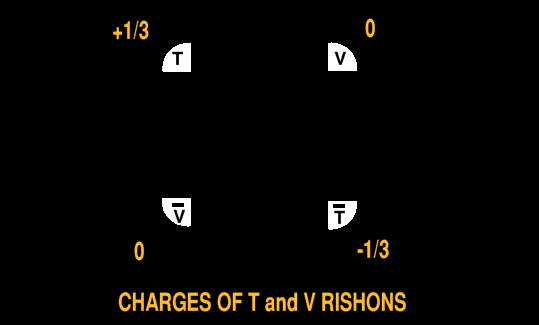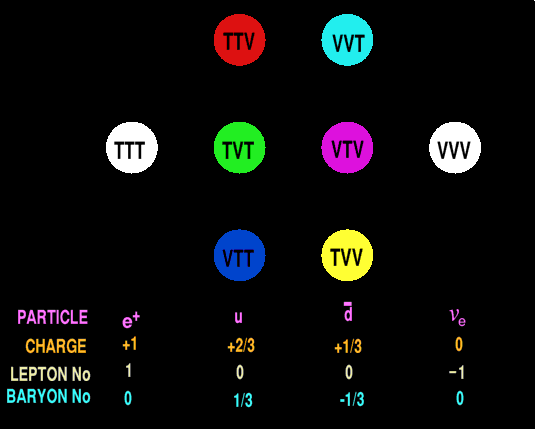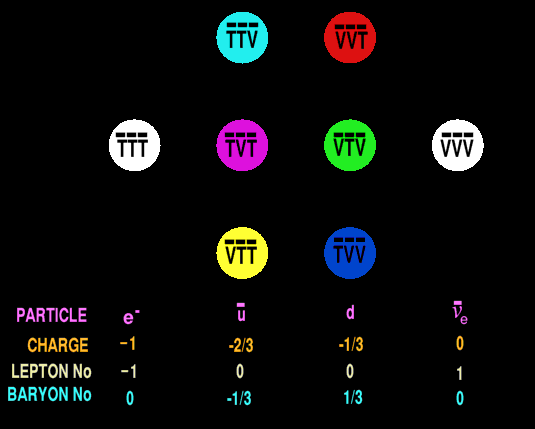
The electrical charges of V, anti-V, T and anti-T rishons


There are only two rishons, T and V, and their anti-particles, anti-T and anti-V, making four altogether. The V rishon is electrically neutral, but the T rishon has a charge of +1/3. [The anti-T rishon has the opposite charge, -1/3]. Quarks and leptons, it is said, comprise three rishons each. No quark or lepton can contain a mixture of both rishon and anti-rishon, they are all either pure rishon, or pure anti-rishon. It is thought that the up and down quarks are the ground state of the two quarks; with the strange and charm quarks being the first excited state; and the top and bottom quarks the second (and ultimate) excited state. Thus the rishons represent the following ground-state families: electron, neutrino, up-quark and down-quark, and their corresponding anti-particles. The second generation (mu-electron, mu-neutrino, strange and charm quarks) are represented by excited states of the same combination of rishons. The third generation (tau-electron, tau-neutrino, top and bottom quarks) are higher excitations still of the same combination of rishons.

Remarkably, due to the up quark comprising rishons, and the down quark anti-rishons, ordinary matter is seen to consist of equal numbers of both rishons and anti-rishons, when the electrons are also taken into account. [Protons and neutrons are mixtures of both up and down quarks].
Note that those rishon composites with mixtures of the two rishons are coloured, they are quarks, and the colour of the quark depends upon the order of the rishons. Note also that those rishon composites composing wholly of V rishons or T rishons are the colourless leptons, either the electron, positron, electron neutrino or electron anti-neutrino.
The triplet combinations of these rishons are all spin-½ particles; the leptons and quarks are all fermions. This would mean, that if the individual rishons had half-integral spin, the three rishons together always have two with opposing spin, cancelling to spin-zero, leaving a residual half-integral spin contributed by the third rishon.
The major difficulty with the Rishon theory comes from the fact that electrons, neutrinos and quarks are point-like and either occupy zero space or are exceptionally small. With three rishons confined within such a small space, Heisenbergs Uncertainty Principle asserts that quarks, electrons and neutrinos should possess much more mass (of the order of hundreds of GeV), than what they do. This is all the more reason to think that quarks, electrons and neutrinos really are point-like fundamental particles, and do not contain further constituents such as rishons.
See Rogers' Twisted Tri-Prism Theory of Quarks
I think that the reader will agree that Rogers' representation of quarks and leptons as shown in his Twisted Tri-Prism Theory is a much more convincing and elegant representation of the relationship between the two families than is the Rishon model, where you are left wondering why, or how, the order matters, as in VVT and VTV for instance. With my Twisted Tri-Prism Theory, the spacial order is inherent, as plain as a knot in space. Another advantage of Rogers' Theory is that there is only one constituent, not three.
|
Preon Stars may not emit much light; that fact and their extremely small size may account for their not yet being discovered. Preon Stars should not emit Hawking Radiation, and should therefore survive to our epoch. They may contribute to the galactic dark matter (which is not the same as Cosmological dark matter, which is non-baryonic and comprises 4.6% mass of the Universe). If, like Neutron Stars, a 1 metre diametre 100 Earth Mass Preon Star during collapse, freezed-in its magnetic field, then its' induced electric field may be as high as 1034Volts/metre, which is more than enough to accelerate Ultra High Energy Cosmic Rays to energies up to the observed 1021eV. Such a high electric field easily exceeds the electric field where the Quantum Vacuum breaks down, being about 1018V/m, so Preon Stars could be emitting extremely high-energy charged particles, and if so this should make them observable. Preons, if they exist, do not exclude the formation of Black Holes; if the Preon Star is denser than a critical amount, a Black Hole will form. Thus the density order of collapsed objects is: White Dwarf (which are prevented from further collapse by the degeneracy pressure of electrons [where no two electrons in the same place are allowed to have the same energy]). When the mass exceeds a certain amount and the degeneracy pressure of electrons is overcome, a Neutron Star will form, where neutron degeneracy pressure counter-balances gravity. If the neutron degeneracy pressure is exceeded then a Preon Star will result, which are prevented from further collapse by Preon degeneracy pressure. Finally, if Preon degeneracy pressure is exceeded, nothing can prevent the ultimate gravitational collapse to a singularity: a Black Hole. Preon models of elementary particles have gone out of fashion today, but there is no experimental data that contradicts the idea.
|
![]()
![]()